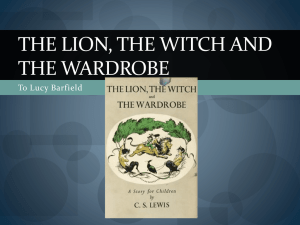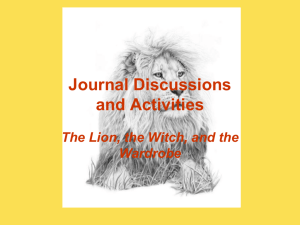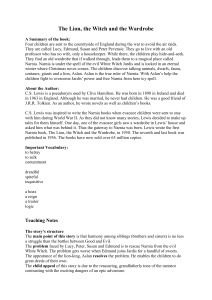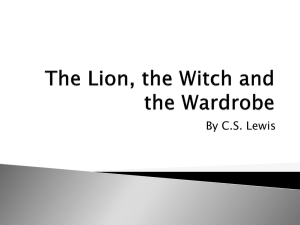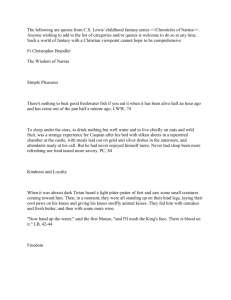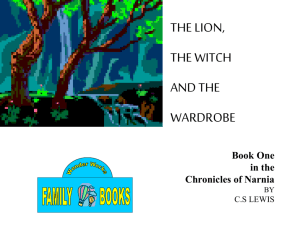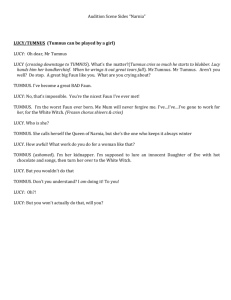The Lion, The Witch and the Wardrobe
advertisement
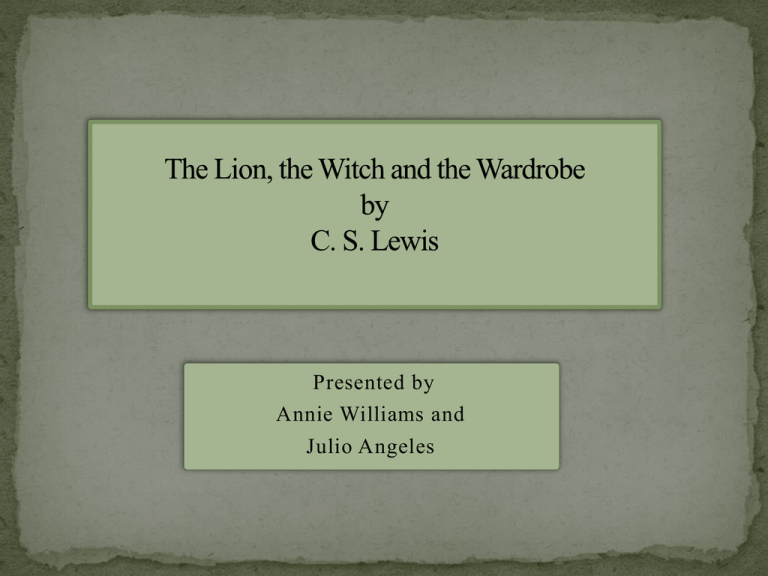
Presented by Annie Williams and Julio Angeles ABOUT THE AUTHOR Name: Clive Staple Lewis Born: November 29 1898 Died: November 22,1963 C.S. Lewis is most famous for The Chronicles of Narnia, but has written other fiction, like The Screwtape Letters and The Space Trilogy. He was a close friend of J.R.R. Tolkien and both were leading English figure at Oxford University. Many writers have been inspired by Lewis, like Daniel Handles (A Series of Unfortunate Events) and J.K. Rowling (Harry Potter) Sadly, his death was not covered due to the assassination of President Kennedy on the same day. BO O K I N F O R M ATI ON Publication Date: 1950 Author: Clive Staple Lewis Publisher: Geoffrey Bless Illustrator and Cover Artist: Pauline Baynes Place of Origin: United Kingdom Series: The Chronicles of Narnia (first book in the series) Genre: Fantasy Translated into: 41 languages Although written and published first, it’s the second book in the series’ internal chronological order, after The Magician’s Nephew. The Pevensies THE MAIN CHARACTERS • Peter: is the oldest and acts as the leader of the siblings and always looks after them. Peter is courageous, determined and strong willed. Through the book, many view him and his siblings as figureheads and symbols of hope. •Susan: is the second oldest , she is understanding, caring and tender hearted. Susan acts as the moral compass to the group and helps protect her younger siblings together with Peter. •Edmund: the third oldest of the kids, he feels jealous of the respect Peter has over his other siblings which leads him to be tricked by the White Witch, and ends up causing a lot of trouble and grief to his relatives. He is later pardoned and welcomed back by his friends and siblings •Lucy: the youngest of the kids, she is courageous, daring and curious. She is the first to discover Narnia and interact with Mr. Tumnus. Professor Digory Kirke: he takes the Pevensie children under his care when they are evacuated from London. He is the only one who believes that Lucy has been to Narnia at first and helps persuade Peter and Susan that Lucy is telling the truth, and seems to know more about Narnia that he leads on. "Either your sister is mad, or she's lying, or she's telling the truth. She's not mad and you say she never lies, so we must assume she is telling the truth” - Prof. Kirke to Susan and Peter Mrs. Macready: housekeeper for Prof. Kirke Mr. Tumnus: the faun, is the first creature that Lucy meets in Narnia. He is shy at first but later befriends Lucy. Although all the Narnians had been ordered to capture any Sons of Adam or Daughters of Eve that they come in contact with by the White Witch, Tumnus changes his mind and decides to let Lucy go. Mr. and Mrs. Beaver: they provide shelter for the children at their home in Beaversdam, and inform them about Aslan and the prophecy of four children that will end the rule of the White witch. In this moment Edmund escapes to see the Witch, leaving his brother and sisters behind. Father Christmas: makes his appearance once the White Witch’s magic is beginning to weaken and delivers gifts to the Pevensies that help them through their journey. Mr. Tumnus Aslan: the lion, and the symbol of all that is good and right in Narnia. Aslan is the true ruler of Narnia, and is one of the central characters in the seven books. Despite his tender and loving nature towards his friends and allies, he is “not a tamed lion”, and he is both powerful and dangerous when the need arises. On this book, Aslan protects, guides and gives advice to the Pevensies, and makes the ultimate sacrifice for one of them. Aslan The White Witch Jadis, the White Witch: the self proclaimed queen and ruler of Narnia and all of its inhabitants, she is arrogant and cruel and rules the land with an iron grip. She has cast a spell on Narnia that makes it “always winter but never Christmas”. Knowing that if the prophecy about the Sons of Adam and Daughters of Eve is fulfilled it would bring about her doom, she orders that if any are found to be handed over to her. She uses Edmund’s weaknesses to get him to betray his kin and side with her, as well as gaining information about the children. Any who dare oppose her are turned to stone. • It’s the beginning of World War II in 1940 and the Pevensie children are evacuating London. They are taken in by Professor Digory Kirke who lives in the country side. • One rainy day, the kids decide to explore the house; Lucy, being curious about the wardrobe in an empty room that she finds, decides to open it and ventures for the first time into Narnia and meets the faun, Mr. Tumnus. He invites Lucy to his home for tea, and tells her all about Narnia and the White Witch. •Lucy returns through the wardrobe, to find out that only a few seconds have gone by while she was in Narnia. She tries to convince the others about Narnia but fails due to the wardrobe returning to normal. On another day, while playing hide and seek, Edmund and Lucy decide to hide inside the wardrobe and find out that it leads to Narnia again. •Lucy disappears in the forest before Edmund could catch up with her, and encounters the White Witch, who introduces herself as the Queen of Narnia, and offers some Turkish Delights to him . She promises to make Edmund Prince, and eventually King if he could take the rest of his siblings to her castle, then departs. Edmund and Lucy return home, and Lucy starts telling Susan and Peter about Narnia again, when asked by the older siblings about this, Edmund denies it saying that they were only playing, which makes Lucy angry at his brother’s lies. •Later on, the house gets some visitors and all the children decide to avoid them, so they decide to go into the wardrobe to hide. All of them enter Narnia and Lucy decides to go to Mr. Tumnus’ cave, but upon arrival, find that the place has been trashed by Maugrim of the secret police and Tumnus has been taken prisoner. •While wondering what to do, they meet Mr. Beaver, who guides to his residence in Beaversdam, and with Mrs. Beaver, explain to the children the prophecy that must be fulfilled in order to overthrow the Witch, mention that Aslan, the great lion and true king of Narnia, is “on the move again.” While the Beavers talk, Edmund runs away towards the Witch’s castle to inform her about his siblings and get rewarded, but is instead imprisoned and treated harshly for not bringing them to her. She orders her minions and Maugrim to find them and bring the castle. •After learning of Edmund’s betrayal, Mr. Beaver decides to go to Aslan’s camp, where all of the Narnians who desire freedom from the Witch are mustering. While on the way there, they meet Father Christmas, who gives them presents: The sword, Rhidon and a shield for Peter; a bow with a quiver full of arrows for Susan, and a magical horn, which, when blown, brings forth aid; to Lucy he gives a small bottle with magical cordial that heals any injury, along with a small dagger to defend herself. •Edmund is brought forth towards the Stone Table, where he is to be killed by the Witch. But to his luck, he is rescued by a party of Narnians and taken to Aslan’s camp. Maugrim in pursuit, arrives near the camp and finds a surprised Susan and Lucy, and is later killed by Peter, for which he gains the title Sir Peter Wolfsbane. The White Witch goes to the camp later on to demand that Edmund is hers, due to the ancient law (deep magic) that states that all prisoners belong to her. Aslan has a plan, and negotiates with Jadis. The result is that Aslan would be handed over to the Witch instead of Edmund. Peter is appointed General of Aslan’s army and is given control of the faith of Narnia while in Aslan’s absence. •Aslan, as promised, goes to the Stone table, where the White Witch awaits. Aslan is humiliated and bound, beaten and his mane cut, all while Lucy and Susan, who had followed him in secrecy witness this. After the Witch and her minions leave to confront Peter’s Army, they both go forth towards the table and begin to cry. They decide to go back and help Peter, who by this time is fighting the Witch and her army, but are surprised when the Stone Table cracks and Aslan is resurrected by Deeper Magic. They hurry towards the Witch’s castle, where they free all the stone turned prisoners, among them Mr. Tumnus, and head towards the battlefield. They arrive just in time to help Peter and save a mortally wounded Edmund, and Aslan slays Jadis, bringing her dark reign to an end. •At the end, the children are crowned Kings and Queens of Narnia, and, 15 years later, return to their world were they turned into children again. They find Ms. Macready still showing the visitors around, and tell the Professor about their adventure. The professor doesn’t doubt them, and says that they will return to Narnia, but never through the Wardrobe again. The possibility of the impossible/faith: by having faith in the children, the Narnians are able to recover their land and gain freedom from their suppressor; the children by having faith in themselves and each other are able to overcome obstacles and mature mentally. Death/War: constantly present; the book opens with evacuation of the children from London to the country side due to the constant threat of air raids and finishes with a great battle- the children and Narnians against the White Witch and her minions. Forgiveness/ Redemption: after the betrayal of one of their siblings, Aslan sacrifices his life in exchange for Edmund’s absolution. Edmund, to redeem himself, fights the With in the battle for Narnia and breaks her wand, greatly increasing the odds of victory for his side. Later, Edmund is crowned King, and the time when he was a traitor to be forgotten. Coming of age: throughout the trials and obstacles that the children faced in Narnia, they were able to understand what it was to take responsibility: not just for their own actions and decisions, but to be responsible for other people as well. Bravery/Courage: through the book, we see the Narnians and the kids become more ascertain to stop Jadis and overthrow her dark rule. They stand for what they believe in against unfavorable odds and emerge victorious. C.S.Lewis became widely know for The Chronicles of Narnia, which secured his place in children’s literature stardom. At the time this book was published, it was common that children’s books to be realistic, while fantasy and fairy tales were only thought appropriate for young kids. The book received various amounts of criticism for the amount of violent and scary incidents and their influence on the young reader. More criticism came in part due to the Christian symbolism that the book has: Aslan and his resurrection at the Stone Table, the title of Sons of Adam and the Daughters of Eve that the Pevensie children were referred as. Some Christian organizations even wanted to ban the book due to it’s “paganism and occultism.” Despite the negative comments, critics and reviewers agreed that it gave female characters more important roles, like Lucy: without her Narnia wouldn't have been found, displayed courage and determination beyond her age and saved many wounded Narnians and a dying Edmund with the vial that Father Christmas gave her. The publishers of the book feared that the negative criticism would affect the book and affect Lewis’ career and future works. Bu, as more people came in contact with the series, they began to appreciate them, and they, along with Lewis became widely know and liked. Due to its depiction of violence, war and death, The Lion, the Witch and the Wardrobe would be best used as follows: Age Range: 8 and up Grades: 6 and up Older kids would be able to get a better meaning of the book an series, but it is advised that younger readers read along with their parents due to some vivid and scary descriptions, for instance, when Aslan is going to be sacrificed at the stone table, it would be frightful towards younger children.

